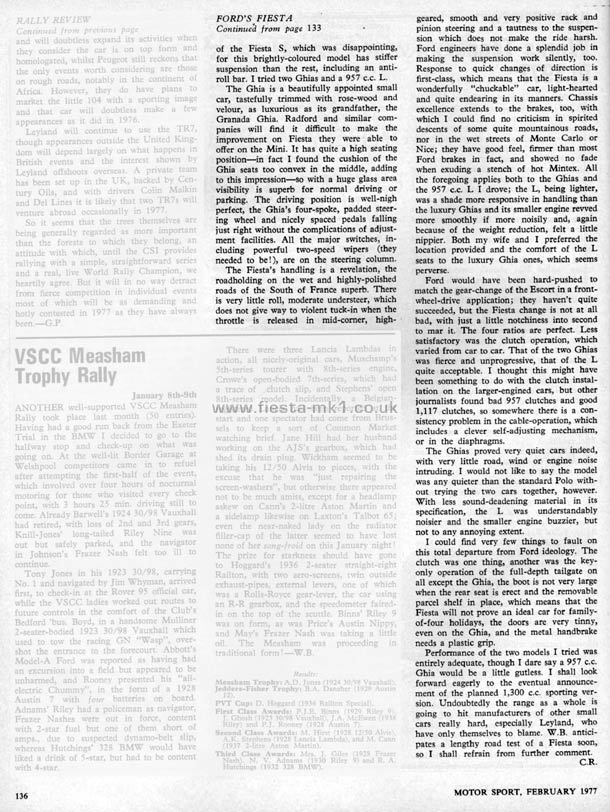Copy of Article Text Below
.....of the Fiesta S, which was disappointing, for this brightly-coloured model has stiffer suspension than the rest, including an anti-roll bar. I tried two Ghias and a 957 c.c. L.
The Ghia is a beautifully appointed small car, tastefully trimmed with rose-wood and velour, as luxurious as its grandfather, the Granada Ghia. Radford and similar companies will find it difficult to make the improvement on Fiesta they were able to offer on the Mini. It has quite a high seating position-in fact I found the cushion of the Ghia seats too convex in the middle, adding to this impression-so with a huge glass area visibility is superb for normal driving or parking. The driving position is well-nigh perfect, the Ghia's four-spoke, padded steering wheel and nicely spaced pedals falling just right without the complications of adjustment facilities. All the major switches, including powerful two-speed wipers (they needed to be!), are on the steering column.
The Fiesta's handling is a revelation, the roadholding on the wet and highly-polished roads of the South of France superb. There is very little roll, moderate understeer, which does not give way to violent tuck-in when the throttle is released in mid-corner, high-geared, smooth and very positive rack and pinion steering and a tautness to the suspension which does not make the ride harsh. Ford engineers have done a splendid job in making the suspension work silently, too. Response to quick changes of direction is first-class, which means that the Fiesta is a wonderfully "chuckable" car, light-hearted and quite endearing in its manners. Chassis excellence extends to the brakes, too, with which I could find no criticism in spirited descents of some quite mountainous roads, nor in the wet streets of Monte Carlo or Nice; they have good feel, firmer than most Ford brakes in fact, and showed no fade when exuding a stench of hot Mintex. All the foregoing applies both to the Ghias and the 957 c.c. L I drove; the L, being lighter, was a shade more responsive in handling than the luxury Ghias and its smaller engine revved more smoothly if more noisily and, again because of the weight reduction, felt a little nippier. Both my wife and I preferred the location provided and the comfort of the L seats to the luxury Ghia ones, which seems perverse.
Ford would have been hard-pushed to match the gear-change of the Escort in a front-wheel-drive application; they haven't quite succeeded, but the Fiesta change is not at all bad, with just a little notchiness into second to mar it. The four ratios are perfect. Less satisfactory was the clutch operation, which varied from car to car. That of the two Ghias was fierce and unprogressive, that of the L quite acceptable. I thought this might have been something to do with the clutch installation on the larger-engined cars, but other journalists found bad 957 clutches and good 1,117 clutches, so somewhere there is a consistency problem in the cable-operation, which includes a clever self-adjusting mechanism, or in the diaphragms.
The Ghias proved very quiet cars indeed, with very little road, wind or engine noise intruding. I would not like to say the model was any quieter than the standard Polo without trying the two cars together, however. With less sound-deadening material in its specification, the L was understandably noisier and the smaller engine buzzier, but not to any annoying extent.
I could find very few things to fault on this total departure from Ford ideology. The clutch was one thing, another was the key-only operation of the full-depth tailgate on all except the Ghia, the boot is not very large when the rear seat is erect and the removable parcel shelf in place, which means that the Fiesta will not prove an ideal car for family-of-four holidays, the doors are very tinny, even on the Ghia, and the metal handbrake needs a plastic grip.
Performance of the two models I tried was entirely adequate, though I dare say a 957 c.c. Ghia would be a little gutless. I shall look forward eagerly to the eventual announcement of the planned 1,300 c.c. sporting version. Undoubtedly the range as a whole is going to hit manufacturers of other small cars really hard, especially Leyland, who have only themselves to blame. W.B. anticipates a lengthy road test of a Fiesta soon, so I shall refrain from further comment.
C.R.
|



